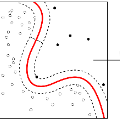Recent advances in AIoT technologies have led to an increasing popularity of utilizing machine learning algorithms to detect operational failures for cyber-physical systems (CPS). In its basic form, an anomaly detection module monitors the sensor measurements and actuator states from the physical plant, and detects anomalies in these measurements to identify abnormal operation status. Nevertheless, building effective anomaly detection models for CPS is rather challenging as the model has to accurately detect anomalies in presence of highly complicated system dynamics and unknown amount of sensor noise. In this work, we propose a novel time series anomaly detection method called Neural System Identification and Bayesian Filtering (NSIBF) in which a specially crafted neural network architecture is posed for system identification, i.e., capturing the dynamics of CPS in a dynamical state-space model; then a Bayesian filtering algorithm is naturally applied on top of the "identified" state-space model for robust anomaly detection by tracking the uncertainty of the hidden state of the system recursively over time. We provide qualitative as well as quantitative experiments with the proposed method on a synthetic and three real-world CPS datasets, showing that NSIBF compares favorably to the state-of-the-art methods with considerable improvements on anomaly detection in CPS.
翻译:AIOT技术的近期进展已导致利用机器学习算法来检测网络物理系统(CPS)运作失灵的机器学习算法越来越受欢迎。以其基本形式,一个异常检测模块监测物理工厂的传感器测量和动因状态,并检测这些测量中的异常现象,以查明异常运行状态。然而,为CPS建立有效的异常检测模型相当具有挑战性,因为模型必须准确检测异常现象,同时发现高度复杂的系统动态和未知的感应噪音。在这项工作中,我们提议了一种新的时间序列异常检测方法,称为神经系统识别和贝叶氏过滤(NSIBF),其中为系统识别设置了专门设计的神经网络结构,即用动态状态空间模型捕捉CPS的动态;然后,在“确定”状态空间模型的顶端自然应用了巴耶西亚过滤算法,以跟踪系统隐藏状态的不确定性,以便随时循环。我们为合成和三个真实的CPS数据集提供了定性和定量试验,其中显示,国家空间局的检测方法具有相当大的可变性。



